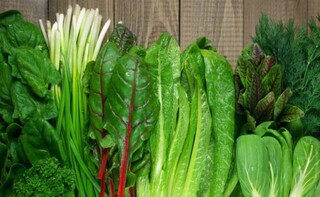Greens are not the most popular fresh foods around, but they are one of the most nutritious ones. They help us load up on essential vitamins, minerals and other micro-nutrients. Methi, Sarson, Kadam and Bathua are greens we all have grown up with. Green leafy vegetables, or GLV as they are known as, are an important part of a balanced diet. They are nutrient dense and contribute immensely to our health. Nutritionists and mothers keep insisting on their importance. Let's look at some new tastes that have been around for centuries but you may have not explored them yet.
6. MoringaMoringa is a hardy tree of the tropics. Its seed pods-drumsticks, flowers and leaves are all edible. It is often called the "Miracle tree" as it is an effective remedy for malnutrition. Moringa leaves can easily be labelled as superfoods and with good reason. The leaves are a rich source of minerals, vitamins, and phytochemicals that are attributed with powerful antioxidant, anti-cancer, anti-inflammatory, anti-diabetic and anti-microbial properties. In an article published in the journal of Food Science and Human Wellness, moringa is said to provide "7 times more vitamin C than oranges, 10 times more vitamin A than carrots, 17 times more calcium than milk, 9 times more protein than yoghurt, 15 times more potassium than bananas and 25 times more iron than spinach". Moringa leaves can be eaten as a cooked vegetable, added to dals and curries, or brewed as tea.
7. Bichhu BootiBichhu Booti or stinging nettle is a plant that grows wild across the Himalayan range. It is attributed with many health benefits and is nutrient-rich. Loaded with carotenoids, Vitamin A and fibre, it adds very little calories and a lot of health benefits to your meal. It is supposed to have ingredients that may decrease inflammation and increase urine output. Kandalee ka saag is a common dish available in Uttrakhand and is made with Bichhu Booti.
8. BharangiBharangi is a plant widely found on the Western Ghats during the monsoon season. It is an important plant for the traditional medicine practitioners across the world. The leaves are rich in flavonoids and phenolic acids. They are used in Ayurveda to stimulate appetite.These are a few wild plants which are used as food. While researching I found about 50-60 of them listed across the country, some of them are not even available in the markets and only the older generations are aware of them. They are nutritious and easy to grow, and now foodies are rediscovering these gems of nature.Disclaimer:The opinions expressed within this article are the personal opinions of the author. NDTV is not responsible for the accuracy, completeness, suitability, or validity of any information on this article. All information is provided on an as-is basis. The information, facts or opinions appearing in the article do not reflect the views of NDTV and NDTV does not assume any responsibility or liability for the same.
Advertisement
Advertisement
6. MoringaMoringa is a hardy tree of the tropics. Its seed pods-drumsticks, flowers and leaves are all edible. It is often called the "Miracle tree" as it is an effective remedy for malnutrition. Moringa leaves can easily be labelled as superfoods and with good reason. The leaves are a rich source of minerals, vitamins, and phytochemicals that are attributed with powerful antioxidant, anti-cancer, anti-inflammatory, anti-diabetic and anti-microbial properties. In an article published in the journal of Food Science and Human Wellness, moringa is said to provide "7 times more vitamin C than oranges, 10 times more vitamin A than carrots, 17 times more calcium than milk, 9 times more protein than yoghurt, 15 times more potassium than bananas and 25 times more iron than spinach". Moringa leaves can be eaten as a cooked vegetable, added to dals and curries, or brewed as tea.
7. Bichhu Booti
Advertisement
8. BharangiBharangi is a plant widely found on the Western Ghats during the monsoon season. It is an important plant for the traditional medicine practitioners across the world. The leaves are rich in flavonoids and phenolic acids. They are used in Ayurveda to stimulate appetite.These are a few wild plants which are used as food. While researching I found about 50-60 of them listed across the country, some of them are not even available in the markets and only the older generations are aware of them. They are nutritious and easy to grow, and now foodies are rediscovering these gems of nature.
Advertisement
For the latest food news, health tips and recipes, like us on Facebook or follow us on Twitter and YouTube.
Advertisement
